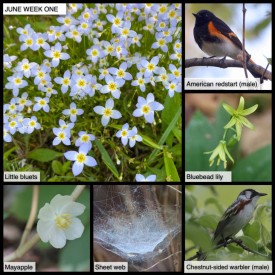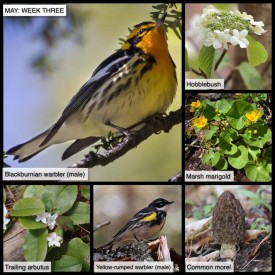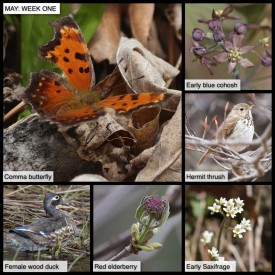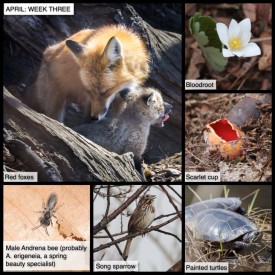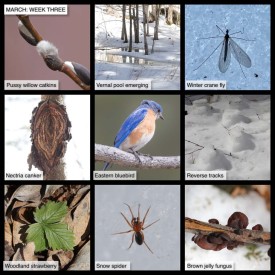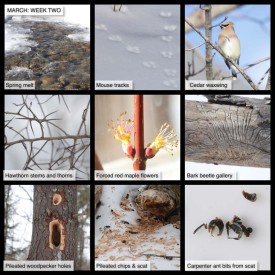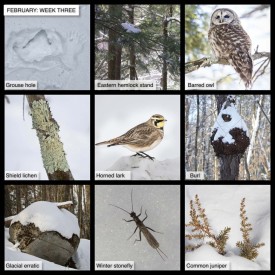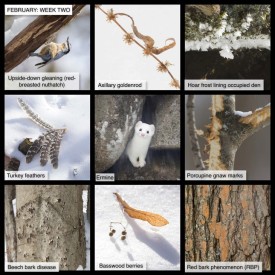This Week in the Woods, Assistant Editor Meghan McCarthy McPhaul discovered a patch of little bluets. Also called known as Quaker ladies, these exquisite little flowers typically grow in…
This Week in the Woods
May: Week Four
This Week in the Woods, the small but spectacular spring wildflower fringed polygala (also called fringed milkwort and gaywings) is in bloom. This little evergreen reproduces both by…
May: Week Three
This Week in the Woods, we spied this male blackburnian warbler hopping between branches in a hemlock tree and running his bill along the flat needles (no doubt to glean insects). Despite…
May: Week Two
This Week in the Woods more warblers are returning, including this black-and-white warbler, which obligingly posed for a photo behind the Northern Woodlands office. Black-and-white warblers…
May: Week One
This Week in the Woods, we’ve seen several pumpkin orange-colored anglewing (Polygonia) butterflies. After some expert input, we’re reasonably confident that the butterfly in the…
April: Week Four
This Week in the Woods, this handsome raccoon passed our remote camera. It was likely heading to a nearby vernal pool for a frog feast; this time of year, we often find raccoon tracks in the…
April: Week Three
This Week in the Woods, some red fox kits are venturing out of the den. As Meghan McCarthy McPhaul notes in this Outside Story essay, fox breeding pairs “generally stay together after…
April: Week Two
This Week in the Woods, we are happy to see that common loons are returning from their coastal winter habitat. At the time the photo was taken, the loon had just resurfaced from under the lake…
April: Week One
This Week in the Woods, sugar maple buds are starting to open in the Upper Valley – a sure sign that sugaring season is coming to an end. Here’s an Outside Story essay by Audrey…
March: Week Five
This Week in the Woods, lakes and rivers have opened up again, and hooded mergansers are back. As Michael Caduto notes in this Outside Story essay, hoodies are short-distance migrants and…
March: Week Four
This Week in the Woods, the great spring melt is progressing rapidly. Even on shady, north-facing slopes, you can now see thaw circles – rings of bare ground around the trunks of trees,…
March: Week Three
This Week in the Woods, the snow’s melting and the March winds roar. Spring is on its way. Out in the wetlands, pussy willow catkins are emerging from their buds. As noted in this…
March: Week Two
This Week in the Woods, we’re seeing more dripping icicles and openings in frozen streams and rivers. The spring melt has begun. This seasonal change has profound impacts on aquatic…
March: Week One
This Week in the Woods, we found this chipmunk peeking out of its winter burrow. There were no dignitaries in top hats to greet him, but the chippie did seem to inspect his shadow before…
February: Week Four
This Week in the Woods, we’ve been grateful for snowshoes with metal teeth. The walking conditions out there are difficult! Editor Cheryl Daigle discovered this perfectly shaped capsule…
February: Week Three
This Week in the Woods, Northern Woodland’s assistant editor Meghan McCarthy McPhaul was “just skiing through the woods, lost in my thoughts, when a grouse burst out of the snow…
February: Week Two
This Week in the Woods we watched a nuthatch seem to defy gravity while gleaning bugs upside-down, on the underside of an almost-horizontal branch, and it occurred to us that strong claws and…
February: Week One
This Week in the Woods we’ve reached the middle of winter (according to Farmer’s Almanac, the exact midway point occurs on Wednesday, February 3 at 4:49 p.m.), and over the…
January: Week Four
This Week in the Woods, and more specifically this past sunny Saturday, we noticed how the new snow in the fields glittered. As Meghan McCarthy McPhaul notes in this Outside Story essay, 5 to…
January: Week Three
This Week in the Woods, Meghan McCarthy McPhaul found tracks along a frozen brook. They were clearly made by a mustelid (member of the weasel family), but which species? Sliding marks and a…


